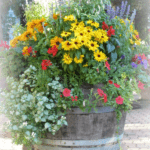When it comes to designing a beautiful flower garden, the small details can make a big difference. One of these important details is the edging, which not only provides a clean and polished look but also serves practical purposes like keeping grass and weeds at bay. In this article, we will explore various edging ideas for flower gardens, from different materials and DIY projects to professional services and seasonal inspiration.
The right edging can define the borders of your flower garden and complement the overall aesthetic. By carefully choosing the appropriate edging materials and designs, you can elevate the look of your garden and create a visually appealing display. Whether you have a large or small flower garden, there are countless edging options to suit your preferences and needs.
In the following sections, we will discuss different types of edging materials such as stone, metal, wood, and brick, along with creative ideas specifically tailored for small flower gardens. We will also provide step-by-step instructions for DIY edging projects and explore the option of hiring professional landscapers for those who prefer professional help.
Additionally, we will offer seasonal edging inspiration to help you enhance your flower garden throughout the year. So let’s dive into the world of edging ideas for flower gardens and get inspired to create a stunning outdoor space.
Types of Edging Materials
When it comes to edging ideas for flower gardens, choosing the right materials can make a significant impact on the overall aesthetic and functionality of the garden. There are various options to consider, including stone, metal, wood, and brick. Each material offers unique characteristics that can enhance the look of the garden while serving practical purposes.
Stone edging is a popular choice for flower gardens due to its durability and natural appearance. It can create a timeless and elegant border for the garden, adding a touch of charm and sophistication. On the other hand, metal edging provides a modern and sleek look, perfect for contemporary or minimalist garden designs. It is also long-lasting and requires minimal maintenance.
Wood edging offers a more rustic and organic feel to flower gardens. It can be easily customized to fit any garden layout or design concept. Additionally, brick edging provides a classic and traditional look that complements various types of flowers and plants. Its versatility makes it suitable for both formal and informal garden settings.
Overall, the choice of edging material should not only align with the aesthetic preferences of the gardener but also consider factors such as durability, maintenance requirements, and compatibility with the overall design theme of the garden. By carefully selecting the right material for edging, one can create a cohesive and visually appealing flower garden that enhances outdoor spaces while protecting plant beds from encroaching weeds or grass growth.
Edging Ideas for Small Flower Gardens
Edging plays a crucial role in enhancing the overall look of flower gardens, creating a clean and polished appearance while also providing practical benefits such as keeping grass and weeds at bay. When it comes to small flower gardens, choosing the right edging is especially important to maximize space and create visually appealing borders. Here are some creative and space-saving edging ideas for small flower gardens that can transform even the tiniest outdoor spaces.
One innovative edging idea for small flower gardens is using low-profile materials such as river rocks or pebbles. These materials not only provide a clean border for the garden but also add a decorative touch without taking up valuable space. Another space-saving edging option is utilizing vertical elements such as mini picket fences or narrow wooden stakes. These features create visual interest without encroaching on the precious planting area.
For those looking to add a touch of whimsy to their small flower gardens, consider using upcycled or repurposed items as edging. Old bicycle wheels, vintage teacups, or even colorful glass bottles can be strategically placed along the garden border for a unique and eclectic look. This not only adds character to the garden but also makes use of items that might otherwise go to waste.
In addition, incorporating edible plants such as herbs or dwarf vegetables into the garden bed itself can serve both as edging and a functional element. Not only do these plants define the garden’s border, but they also provide fresh herbs or vegetables for culinary use. By implementing these creative and space-saving edging ideas, small flower gardens can achieve big impact in terms of both aesthetics and functionality.
| Edging Ideas | Benefits |
|---|---|
| River rocks or pebbles | Space-saving, decorative |
| Vertical elements (mini picket fences, narrow wooden stakes) | Visual interest without taking up planting area |
| Upcycled/reused items (bicycle wheels, teacups, glass bottles) | Unique and eclectic look |
DIY Edging Projects
Edging your flower garden not only adds a finishing touch to the overall look of your outdoor space, but it also serves practical purposes. It helps define the garden bed, prevents grass and weeds from encroaching, and provides a barrier for containment of mulch or other ground covers.
If you are looking to get creative with edging ideas for flower gardens, there are numerous do-it-yourself (DIY) projects that you can take on to achieve a unique and personalized look.
One popular and cost-effective option for DIY edging is using recycled materials such as old tires, bottle caps, or even reclaimed wood. These materials can be repurposed into charming and eco-friendly borders for your flower garden.
For example, old tires can be painted in vibrant colors and stacked on top of each other to create an eye-catching and playful border. Similarly, bottle caps can be arranged in patterns or designs and embedded into the ground for a colorful and eclectic edging.
Another DIY edging idea for flower gardens is creating a natural border using rocks or pebbles. This rustic and organic option can add texture and visual interest to your garden. By arranging various sizes of stones in a sinuous pattern along the edge of the flower bed, you can achieve a beautiful and timeless look.
If you have some carpentry skills, building your own wooden edging can add a warm and inviting touch to your flower garden. Using pressure-treated wood or cedar boards, you can construct custom borders that complement the style of your garden. Whether you opt for straight lines or curved edges, wooden borders offer versatility in terms of design and size.
| Edging Material | DIY Project Idea |
|---|---|
| Recycled Materials (tires, bottle caps) | Create colorful borders by repurposing old items |
| Rocks or Pebbles | Create a natural looking border with rustic appeal |
| Wooden Boards (pressure-treated or cedar) | Construct custom borders that match garden style |
Professional Edging Services
When it comes to creating stunning and well-maintained flower gardens, many homeowners may not have the time or expertise to tackle the edging themselves. This is where professional landscapers come in, offering their skills and knowledge to create beautiful and functional edging for flower gardens. Hiring a professional can be a great option for those who want a polished and expertly executed look without the hassle of DIY projects.
Benefits of Professional Edging Services
One of the main advantages of hiring professional landscapers for edging flower gardens is the level of expertise they bring to the table. These professionals have experience working with various edging materials and can recommend the best options based on the specific needs and aesthetic preferences of their clients. Additionally, professional landscapers can ensure that the edging is installed correctly, providing a clean and seamless finish that enhances the overall look of the garden.
Another benefit of enlisting professional edging services is the time-saving aspect. For busy individuals or those with limited gardening experience, hiring professionals can save valuable time and effort. Instead of struggling with DIY projects or spending hours researching edging ideas for flower gardens, homeowners can rely on experts to handle all aspects of the process, from design to installation.
Factors to Consider When Hiring Professional Landscapers
Before choosing a professional landscaping company for edging flower gardens, there are several factors to consider. It’s important to research potential contractors and read reviews from previous clients to gauge their reputation and quality of work.
Additionally, homeowners should inquire about past projects related to edging ideas for flower gardens in order to assess whether the landscaper’s style aligns with their own vision. Lastly, obtaining multiple quotes and comparing services offered by different companies can help homeowners make an informed decision when selecting a professional landscaper for their flower garden edging needs.
Seasonal Edging Inspiration
As the seasons change, so do the landscaping needs of your flower garden. Each season brings its own set of challenges and opportunities for creating an eye-catching edging that complements the natural beauty of your flowers. From the vibrant colors of spring to the warm hues of fall, there are numerous edging ideas that can enhance the seasonal appeal of your flower garden.
Spring Edging Ideas
Spring is a time of renewal and growth, making it the perfect opportunity to showcase the beauty of your flower garden with unique edging ideas. Consider using brightly colored stones or bricks to create a border that complements the pastel tones of spring blooms. You can also opt for low-maintenance plants like creeping thyme or sedum as a natural and elegant edging option for a touch of greenery.
Summer Edging Inspiration
During the hot summer months, it’s important to choose edging materials that can withstand high temperatures and sun exposure. Metal or plastic landscape edging can be a durable option for delineating your flower beds and pathways. For a more organic look, consider using driftwood or bamboo as an unconventional yet stylish edging material that adds a beachy vibe to your garden.
Fall Edging Suggestions
As the weather cools down, it’s time to transition your flower garden into the cozy ambiance of fall. Redefine your garden borders with rustic wooden logs or reclaimed timber for a charming and autumnal feel. Planting ornamental grasses like fountain grass or switchgrass along the edge can also add texture and movement to your garden as they sway in the breeze.
By incorporating these seasonal edging ideas into your flower garden, you can create a visually appealing landscape that evolves with the changing seasons while maintaining its overall aesthetic appeal all year round. Whether you’re embracing the freshness of spring, savoring the warmth of summer, or embracing the coziness of fall, there are endless options for enhancing your flower garden with creative edging ideas tailored to each season’s unique characteristics.
Edging Maintenance
Edging in flower gardens not only serves a functional purpose by containing the soil and preventing the spread of grass and weeds, but it also adds a beautiful finishing touch to the overall look of the garden. However, in order to maintain its aesthetic appeal, proper care and maintenance of the edging is essential. Here are some tips for maintaining and caring for the edging in flower gardens:
1. Regular Inspection: Periodically inspect the edging material for any signs of damage, such as cracks, dislodgement, or rust (if metal). Catching these issues early on can prevent further damage and costly repairs.
2. Weed Control: Keep the area around the edging free from weeds and overgrown grass. This not only maintains a neat appearance but also prevents invasive plants from damaging the edging material.
3. Cleaning: Depending on the type of material used for the edging, regular cleaning may be necessary to remove dirt, moss, or algae buildup. Use appropriate cleaning methods such as pressure washing for stone or brick edging.
4. Sealants and Protective Coatings: For certain materials like wood or metal, applying sealants or protective coatings can help prolong their lifespan by providing a barrier against moisture and UV damage.
5. Repair as Needed: If any damage is spotted during inspection, make timely repairs to prevent it from worsening. This may involve repositioning loose stones or bricks, resealing joints, or replacing damaged sections of wood or metal.
By following these maintenance tips, gardeners can ensure that their flower gardens maintain a polished look all year round while prolonging the lifespan of their chosen edging material.
Edging for Specific Flower Types
When it comes to flower gardens, the type of edging used can make a significant impact on the overall aesthetic appeal and maintenance of the garden. Different types of flowers may require specific edging ideas to complement their unique characteristics and growing patterns. For instance, roses, tulips, and daisies are popular choices for many gardeners, each requiring their own tailored edging solutions.
Roses are known for their beauty and fragrance, making them a beloved addition to any garden. When it comes to edging ideas for rose gardens, consider using materials such as metal or stone to create a classic and elegant look. Additionally, incorporating curved or scalloped edging can complement the romantic nature of roses while providing a boundary that is gentle on their delicate petals.
Tulips are vibrant and colorful flowers that can bring life to any garden space. For tulip gardens, consider using low-profile edging materials such as brick or wood to allow the focus to remain on the striking blooms. Consider creating gentle curves or wavy patterns with the edging to mimic the natural growth pattern of tulips and create a visually appealing border.
Daisies are charming and cheerful flowers that are often found in more casual garden settings. When it comes to edging ideas for daisy gardens, opt for materials such as gravel or river rocks for a relaxed and natural look. Creating an irregular edge with these materials can add a whimsical touch to the garden while also providing a durable border that complements the carefree nature of daisies.
By tailoring edging ideas specifically for different types of flowers such as roses, tulips, and daisies, gardeners can enhance the beauty of their flower beds while also providing practical benefits in terms of maintenance and care. Whether using metal for roses, low-profile materials like brick for tulips, or natural elements like gravel for daisies, there are endless opportunities to get creative with edging in flower gardens.
Conclusion
In conclusion, it’s clear that edging plays a crucial role in enhancing the beauty and overall aesthetic appeal of flower gardens. Whether it’s through the use of stone, metal, wood, or brick, the right edging materials can truly elevate the look of any garden space. Additionally, for those with limited space, there are plenty of creative and space-saving edging ideas that can be implemented to make small flower gardens stand out.
For those who enjoy do-it-yourself projects, creating your own edging for flower gardens can be a rewarding endeavor. With the right materials and a bit of creativity, unique and personalized edging can be added to any garden. However, for those who may not have the time or expertise to tackle such projects, considering professional edging services could be a worthwhile investment.
Lastly, it’s important to note that proper maintenance is essential for preserving the longevity and aesthetic appeal of garden edging. By regularly caring for the edging materials and ensuring they remain in good condition, flower gardens can continue to showcase their beauty throughout various seasons. Ultimately, with tailored edging ideas for specific flower types and seasonal inspiration in mind, individuals are urged to explore their creativity and personalize their flower gardens with unique edging solutions.
Frequently Asked Questions
What Is the Best Edging for Flower Beds?
The best edging for flower beds ultimately depends on personal preference and the overall aesthetic of the garden. Common options include metal, plastic, stone, brick, or wood. Consider the style, durability, and cost when choosing the best edging for your flower beds.
What Is the Cheapest Way to Do a Edging?
One of the cheapest ways to edge a flower bed is by using simple materials such as recycled plastic or metal strips, which are often available at affordable prices. Another option is to repurpose old bricks or stones for a cost-effective edging solution.
How Do You Edge Around a Flower Garden?
Edging around a flower garden involves first marking the desired border with rope or spray paint. Then, use a spade to create a clean edge along the marked line. After that, install your chosen edging material along the newly created border, making sure it’s level and secured in place.

Welcome to my gardening blog! I am passionate about plants and enjoy sharing my knowledge and experiences with others. In this blog, I will write about everything related to gardening, from tips on how to get started to updates on my own garden projects.





